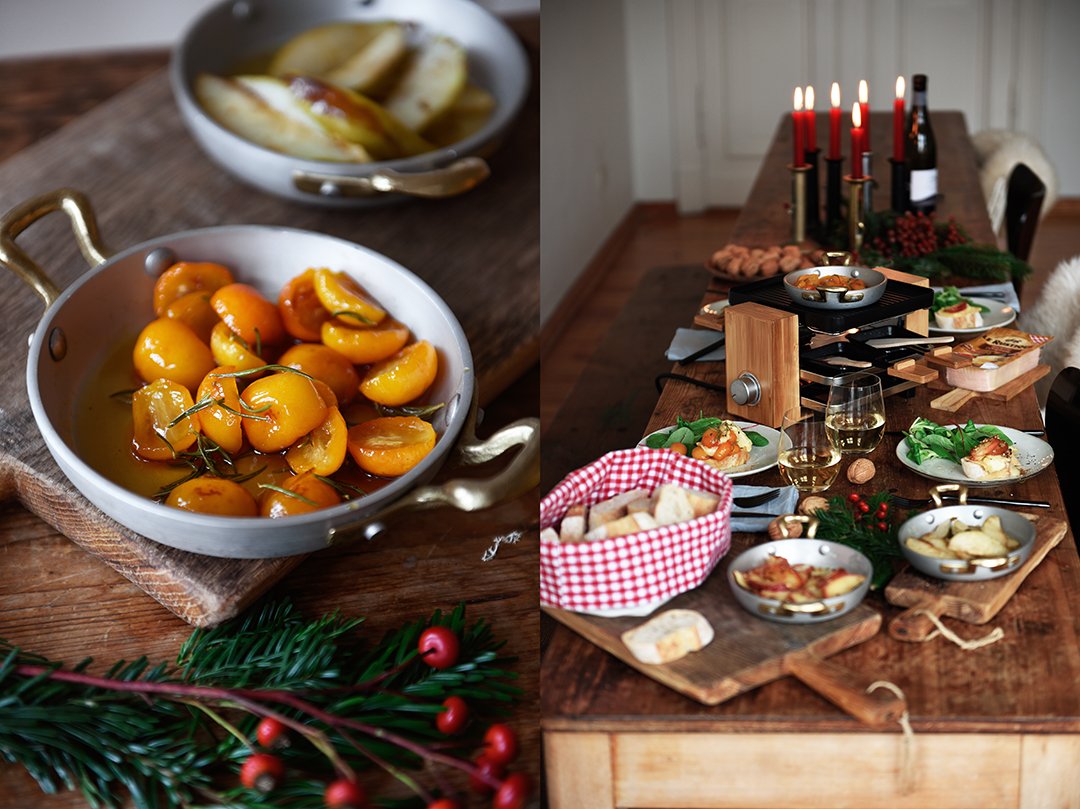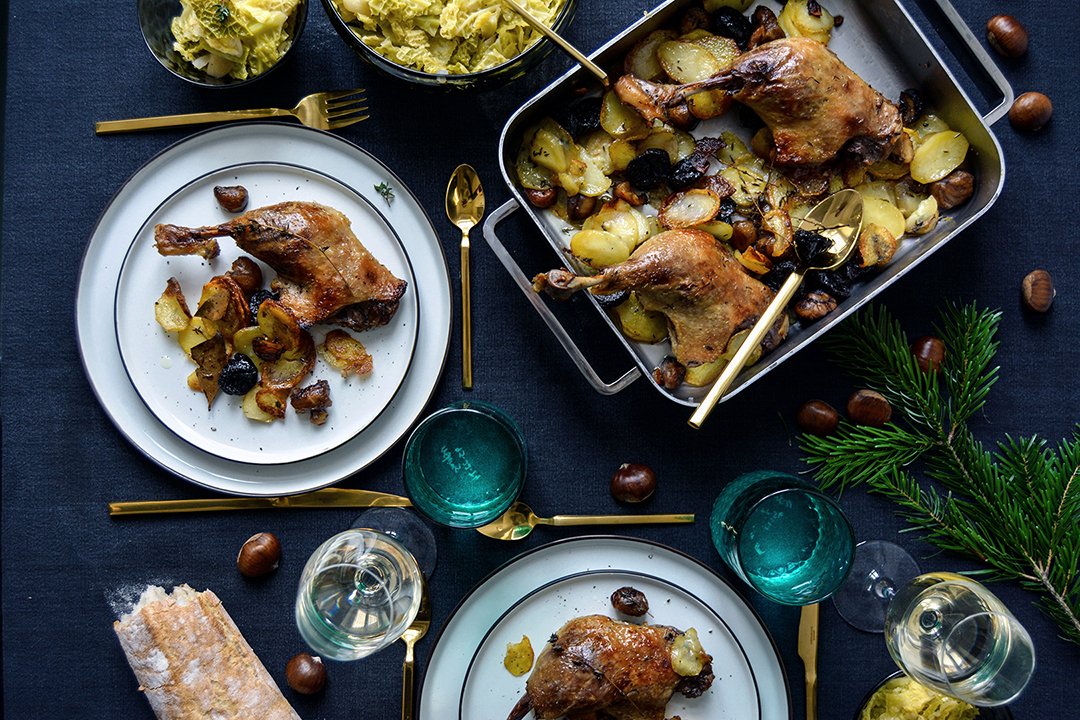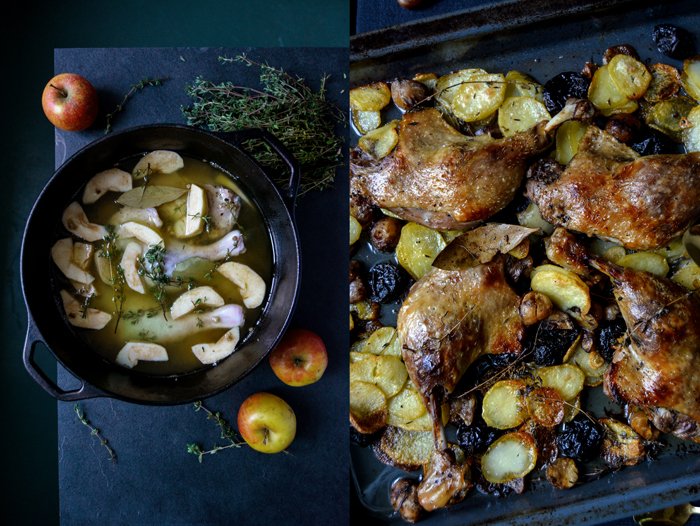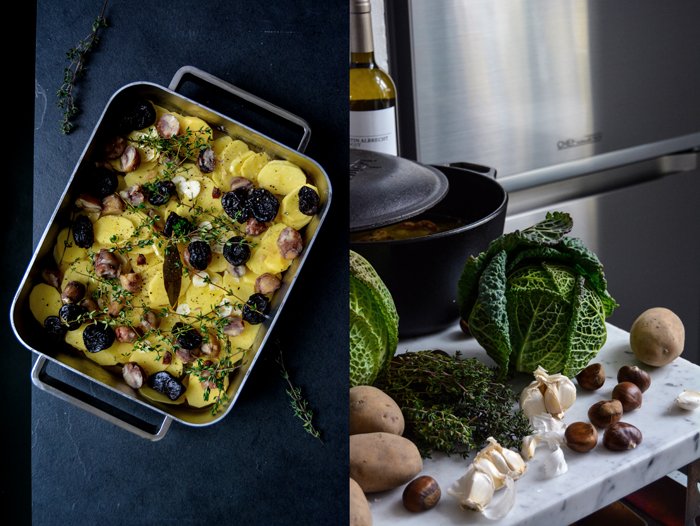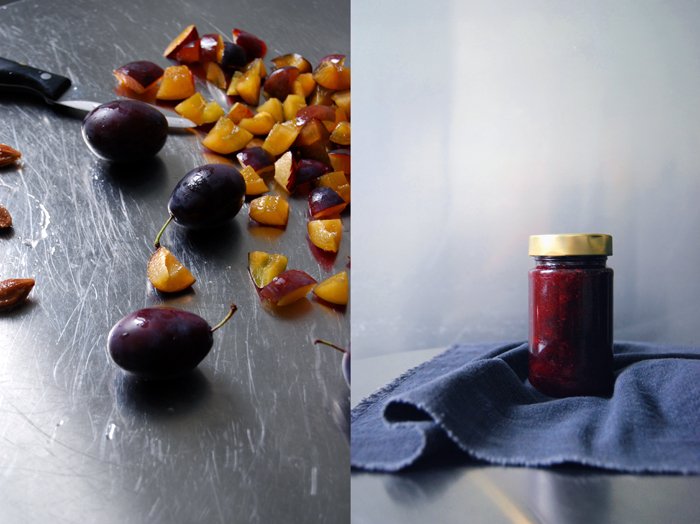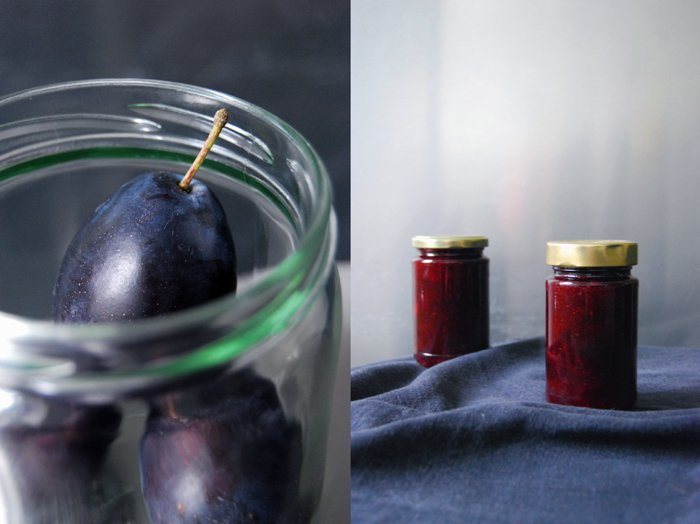Grilled Raclette with Rosemary Kumquats, Coriander Apple & Star Anise Pear
The light dimmed, tall candles casting flickering shadows on the ceiling, the room filled with the dry heat from the crackling fireplace and the smell of burnt wood and cheese lying in the air like a heavy cloud. When it's time for Raclette at my mother's house in the countryside, it's a celebration of everything that I connect with coziness. Surrounded by family and friends, everybody gathers around the sizzling Raclette grill to watch the magic happen: aromatic cheese melting and dripping, golden bubbles bursting and splashing as they touch the glowing grill, and the rind turning into smokey charred bites.
When you eat Raclette at a snow covered hut in the mountains, you would most likely enjoy it the classic way, with boiled potatoes, raw spring onions, pickled vegetables like gherkins (cornichons) and pearl onions, and lots of crushed or coarsely ground black peppercorns. The cheese needs added acidity, which can come from the pickles but it can also come from fruit.
So here's the fruity way to enjoy the fragrant melted cheese on a crusty baguette: I skip the pickles and go for Raclette with rosemary kumquats, coriander apple, and star anise pear. Kumquats cooked with honey and fresh rosemary turn the tiny citrus fruits into soft and caramelized bites. Pear wedges seared in star anise butter taste like Christmas and apple wedges softened in coriander butter are sweet, aromatic, and slightly sour. That's the colorful trio to complete my rustic Raclette table but you could also add roasted grapes or plums, or juicy persimmons. Whatever fruit you would normally eat with cheese will fit; it can only become better with a little heat, either in the pan on the hob or under the grill. The heat softens the fruit's texture and makes the flavor even more concentrated. I would keep the side dish simple, you can serve the grilled Raclette with a quick green salad.
My mother always uses a very old Swiss made grill that's rather large. It can hold half a wheel of Raclette, melting the surface where the cheese is cut in half, and then you scrape the melted layer right off the wheel onto your plate. It's a lot of fun, but it's heavy, you need a lot of people to eat up half a wheel of cheese, and you can only feed the hungry crowd in batches - around two people every time you scrape the top layer off, then the half-wheel needs to go under the grill again. This is not necessarily a bad thing seeing as we're talking about a meal that's rather rich and filling. A break once in a while doesn't harm the hungry cheese lover, but if I want to throw a cozy Raclette party just for two (or maybe a couple friends), I go for my more practical tabletop grill with single Raclette dishes instead. Then I opt for sliced cheese and grab Le Rustique's Raclette l'Originale. It's aromatic yet not overpowering and melts like butter. When I use sliced cheese I remove the rind, and if you're after that smokey burnt touch you can just leave the Raclette on a little longer until the charred bubbles burst under the grill.
Thanks to Le Rustique for sponsoring this post and reminding me of the coziest celebration of cheese: watching - and eating - bubbling and crackling Raclette.
Grilled Raclette with Rosemary Kumquats, Coriander Apple and Star Anise Pear
You'll need a Raclette grill for this recipe.
Serves 3 to 4
For the fruit
2 tablespoons honey
2 tablespoons fresh rosemary needles (whole needles, not chopped)
12 fresh organic kumquats (or canned kumquats, drained), cut in half lengthwise and seeds removed
4 tablespoons freshly squeezed orange juice
Unsalted butter, to cook the pear and apple
3 star anise
1 large, firm pear, cored and cut into thin wedges
2 teaspoons coriander seeds, crushed with a mortar and pestle
1 large baking apple, cored and cut into thin wedges
For serving
About 500-600g (18-21 ounces) sliced Raclette cheese (for a tabletop grill with single Raclette dishes), rind removed
1-2 crunchy baguettes, sliced
Crushed or coarsely ground black peppercorns
Optional
2 large handfuls mixed small leaf lettuce (young spinach and chard, mâche or corn lettuce)
Olive oil
Balsamic vinegar
Fine sea salt
Finely ground pepper
For the kumquats, in a small, heavy pan, heat the honey over high heat until bubbling. Add the rosemary, kumquats, and orange juice and cook, turning once, for 3-4 minutes or until golden brown and soft - mind that the kumquats don't burn. Set the pan aside and keep warm.
For the pear, in a medium, heavy pan, heat 2 tablespoons of butter and the star anise over medium-high heat until sizzling. Add the pear wedges and sauté, turning once, for about 3-4 minutes or until golden brown and tender. Set the pan aside and keep warm.
For the apple, in a medium, heavy pan, heat 2 tablespoons of butter and the coriander seeds over medium-high heat until sizzling. Add the apple wedges and sauté, turning once, for about 3-4 minutes or until golden brown and tender. Set the pan aside and keep warm.
Melt the cheese, one slice at a time, under the Raclette grill until bubbly then scrape onto a slice of baguette, top with kumquats, apple wedges, or pear wedges and season with crushed black pepper.
You can serve the grilled Raclette with a simple green salad on the side: Divide the mixed lettuce leaves among the plates, drizzle with a little olive oil and balsamic vinegar, and season to taste with salt and pepper.
Enjoy!
Christmas Duck Confit with Roast Potatoes, Chestnuts, Plums, and Star Anise
Berlin, December 2015:
It's only a week until Christmas and I'm starting to get excited! The culinary plan for the holidays isn't complete yet, there are still a few important questions to discuss, but flambéed Christmas Pudding for dessert and my obligatory slow roasted duck are already on the list. In the past 2 years of eat in my kitchen, I shared 2 Christmas recipes with you that feature a whole duck cooked for hours at very low temperature. This year, I decided you deserve a break - although I'll still put mine in the oven, early, on the 24th for Christmas Eve, at 85°C / 185°F, as always.
Recently, I had another one of my food phone calls with my mother, we spoke about confit de canard, duck legs cooked in the oven for hours in a dutch oven full of the bird's fat. The meat is succulent and meltingly tender and - conveniently - you can use the fat that it cooked in for months to fry potatoes and sear your meat. It's the best! I decided to have a little pre-holiday-celebration and cook a Christmas-y duck confit roasted on crispy potatoes refined with chestnuts, dried plums, and star anise. Although the duck legs don't need as long as my whole Christmas duck, you'll need about 1 1/2 days in advance for the preparation. First, you marinate the meat in salt and herbs for a few hours, or preferably overnight. The next day, you'll cook the legs in the oven in 1kg / 2 1/4 pounds of duck or goose fat (for 4 legs), I used goose fat as I forgot to place my order at the butcher in time but it works just as well. It takes about 2 1/2 hours before the meat almost falls off the bones - it's beautifully tender but pale at that point. Now, you can either keep the duck confit in the fridge until you'll need it - you could even store it for months as long as it's completely covered in fat (although I have never tried that). Instead, I would turn the oven on the next day, lay the legs on top of thinly sliced potatoes and roast everything for about 30 minutes (plus 20 minutes for the potatoes before you lay the meat on top). You use some of the tasty fat - that you'll have plenty of - to cook the duck and vegetables to crisp and golden brown perfection. During this time, I cooked a bowl full of apple Savoy cabbage, fresh and light without cream but with tender bite instead.
If you spread the preparation over 2 1/2 days it's quite an easy Christmas lunch - or dinner - that doesn't actually demand much work, just the right logistics. And if you're still looking for some really good wine for Christmas, we already made our choice: We'll enjoy Martin Albrecht's Gelber Muskateller (Muscat) and his 2012 Herbstnebel (Syrah, Cabernet-Sauvignon and Nebbiolo)! I wrote about his fantastic wine a couple months ago, click here to find out more about his old vineyards in the south of Germany.
Apart from this culinary pre-celebration, there was also a pre-Christmas gift that I got overly excited about: we have a new fridge in the house! In the past few months, while cooking and baking even more than usual due to my book, I often suffered from my old fridge's limitations and I knew that something had to change sooner or later. I did some research behind the silver doors of today's chic refrigerators, which all look quite similar from the outside. I remembered a tall model by Samsung that had caught my attention last year but at that point, my 12-year old fridge was still fully functioning and I was still forgiving regarding its limitations. So when Samsung had invited me to a presentation of their latest Chef Collection, a series of kitchen appliances developed together with Michelin-starred chefs, I wasn't ready for a change yet. But as soon as they offered me this huge, elegant silver fridge, after months of trying to fit in all the vegetables that I needed to cook and shoot for my book, I said "Yes, please!" I got it - thank you so much for that Samsung - and I'm totally happy about the fact that it keeps the temperature constantly stable and is especially energy saving - and I particularly enjoy the telescopic slide out drawer at the bottom, the Chef Zone. Maybe this is how some people feel about cars, but these little details are more than just practical, this is fun! But first and foremost, it's huge compared to our old fridge and I love it. There's so much space that I haven't even managed to fill it yet but I'm sure this will change next week, once the Christmas shopping begins.
Duck Confit with Potatoes, Chestnuts, Plums and Star Anise
Serves 4
For the duck confit
coarse sea salt 1 1/2 tablespoons
black peppercorns, crushed in a mortar, 1 1/2 teaspoons
duck legs 4
fresh thyme 1 small bunch
duck or goose fat (jarred, or fresh uncooked goose fat from your butcher, cleaned from skins and veins, finely chopped) about 1 kg / 2 1/4 pounds
firm, sour apple, peeled, cored and sliced, 1
bay leaves 2
For the roast duck legs and potatoes
medium, waxy potatoes, peeled and very thinly sliced, 8
pre-cooked chestnuts 200g / 7 ounces
dried plums 150g / 5 ounces
garlic, thinly sliced, 3 cloves
star anise 3 pods
a small handful fresh thyme sprigs
fat used to cook the duck, about 180ml / 3/4 cup
coarse sea salt
black peppercorns, crushed in a mortar
For the apple Savoy cabbage
fat used to cook the duck 3 tablespoons
medium onion, finely chopped, 1
a small head of Savoy cabbage, cut into quarters, cored, roughly chopped, rinsed and slightly wet, about 500g /17 1/2 ounces
firm, sour apple, peeled, cored and roughly chopped, 1
dry white wine about, 300ml / 1 1/4 cups
nutmeg, preferably freshly grated
fine sea salt
ground pepper
Day 1
For the duck confit, combine the salt and pepper. Lay the duck legs in a baking dish, rub the skin with the salt-pepper mix and lay half the thyme under the meat and the other half on top. Cover with plastic wrap and keep in the fridge for a few hours, preferably overnight.
Day 2
Set the oven to 120°C / 250°F (conventional setting). Rub the salt off the duck legs with a paper towel, reserve the thyme sprigs.
Melt the (jarred) duck or goose fat in a large dutch oven over medium heat. If you use fresh goose fat from your butcher, let the cleaned and chopped fat cook over medium-high heat for 1 1/2 minutes or until the fat is melted. Take the dutch oven off the heat and let the fat cool for 2 minutes. Add the duck legs, the reserved thyme sprigs, the apple slices and bay leaves, everything should be covered in fat. Place the pot, uncovered, in the oven and cook for 2 1/2 hours. Take the dutch oven out of the oven and continue roasting the legs or cover the dutch oven and roast the legs the next day.
Once the duck legs are roasted you can pour the remaining fat in a sterilized jar and keep it in the fridge for months. It's great for fried potatoes, roasts and cabbages.
Day 3
Set the oven to 220°C / 425°F (conventional setting).
Spread the potatoes in a large baking sheet (don't use a small baking dish like in the picture below, I had to transfer them to a bigger sheet after 10 minutes as they were too moist). Add the chestnuts, plums, garlic, star anise, thyme, and fat, season with salt and pepper, and toss to combine with your fingers. Roast for 10 minutes, stir, and roast for another 10 minutes. Take the duck legs out of the fat - if the fat is hard place the dutch oven over medium heat to soften it - and lay them on top of the potatoes, skin side up. Roast in the oven for 25-30 minutes, stirring the potatoes every 10 minutes, or until crisp and golden brown.
While the potatoes are roasting, cook the cabbage: In a large pot, heat the fat over medium-high heat. Add the onion and cook for a few minutes until soft and golden. Add the cabbage and apple, stir, and cover. Lower the heat to medium and cook for 1 minute. Add the wine, nutmeg, salt and pepper and cook for 10-15 minutes or until the cabbage is just tender. Season to taste.
Arrange the duck legs and the potatoes on plates, serve with the cabbage filled in little bowls.
Pear & Star Anise Tarte Tatin
Ten years ago, on Bonfire Night, I moved to England. I lived in a tiny harbour village called Whitby in the far, far North close to the old city of York. To reach this secluded and picturesque place, you have to drive through the silent moors of North Yorkshire. At one point you will see the river Esk with its pretty swing bridge, and if you follow the water, passing the wooden piers, you'll end up right in front of the dark, rough waves of the North Sea. If you take a left, you can walk down the endless beach under the cliffs for hours until you reach Sandsend. If you take a right, you'll get to the Gothic ruins of the Whitby Abbey from the 13th century, high above the East Cliff overlooking the sea. This mystical place inspired Bram Stoker to write his novel Dracula; here, Captain Cook also learned seamanship and this is where I fell in love with England.
So it's a very special place for me, with precious people and memories, and - of course - amazing food experiences. Especially Botham's, the local bakery, stole my heart and awoke my love for British pastries. Every year in November, I feel a strong pull to go there again, or at least to England. This year, the feeling was particularly strong, but my work on the German translation of my book doesn't really allow me to travel for long. I needed an excuse. I thought it would be a very nice idea to prepare a few new meet in your kitchen features for the Christmas season, and why not in England? I booked the flights, and although I'll only be in London for 3 days, I managed to set up 4 kitchen sessions with wonderful people whose work I deeply admire and I can't wait to turn the oven on together with them.
I still have to wait another 2 weeks and until then, I'll keep it warm and cozy in my own kitchen. Autumn's pears meat Christmassy star anise to melt in a golden brown pan of caramelized fruits and spice covered in crisp short crust pastry. Baked in the oven and flipped around, this becomes a Tarte Tatin. It works for a late breakfast, it's pleasant at teatime and I love to enjoy the last bites at our traditional Sunday pizza night. The recipe is based on my mother's tart, only the apples gave way for more wintery aromas.
Pear & Star Anise Tarte Tatin
For this tart you will need a 21cm / 8″ ovenproof Tarte Tatine dish or frying pan.
butter 90g / 3 ounces
granulated sugar 90g / scant 1/2 cup
star anise 2 pieces
large, crisp pears, peeled, cored and quartered, 3
For the shortcrust
plain flour 130g / 1 cup
granulated sugar 1 tablespoon
a pinch of salt
butter, cold, 75g / 3 ounces
egg yolk 1
cold water 1 1/2 tablespoons
For the shortcrust, combine the flour, sugar and salt in a large bowl. Cut the butter with a knife into the flour until there are only small pieces left. Continue with your fingers and quickly rub the butter into the flour. Add the egg yolk and water, continue mixing with the hooks of your mixer until you have a crumbly mixture. Form a thick disc, wrap in cling film and put in the freezer for 10 minutes.
Set the oven to 200°C / 390°F.
In a pan or a Tarte Tatin dish, melt the butter and sugar, add the pears and star anise and cook on high heat for about 12 minutes. Turn the fruits a few times and watch them well, they should be golden brown and caramelized. Take the pan off the heat when the pears are done.
Roll out the dough between cling film, big enough to cover the pan. Lay the flat pastry on top of the pears tucking the edges down the sides. Bake in the oven for 15 minutes or until golden brown. When the tart is done and the caramel is still liquid, place a large, heat resistant plate on top and flip the pan around carefully. Enjoy warm or cold, pure or with whipped cream.
Tyrolean Plum Jam with Cinnamon and Star Anise
This is the kind of jam I would eat for breakfast in the mountains, in an old wooden hut, the morning table strewn with rustic delicacies, thick slices of a hearty loaf of bread, Tyrolean prosciutto, strong cheese, rich butter and this dark jam. It's very fruity and concentrated. The purple fruits cook for around 20 minutes with cinnamon and star anise which gives this thick spread a warm autumn touch (I don't really like to call it wintery yet, it's still too early in the year). The little pieces of the fruits' skin curl up and turn into caramelised fruit bites, delicious!
For my jams, spreads and chutneys, I always try to find the ripest fruits possible, it makes such a difference in taste! Especially when it comes to plums which develop the best side of their strong aromas when they start to soften. Natural sweetness, that's all you need! A hard and sour fruit won't develop its whole range of flavours in a jam.
I call this my Tyrolean Plum Jam as my mountain memories lie in Corvara in the Alta Badia region in South Tyrol. We used to spend many winter holidays in the Italian Dolomite Alps when I was a child, a time of hearty mountain food, aromatic cakes and strudels and some of the best breakfast tables I've ever had!
Tyrolean Plum Jam with Cinnamon and Star Anise
When you cook jam you should always use a tall pot to prevent the jam from boiling over. The fruits will be two to three times as high when they’ve reached boiling point! My pot is 24cm / 9.5″ high and 20cm / 8″ wide.
For 3-4 medium sized jars you need
ripe dark plums (preferably damson plums), pitted and chopped, 1kg/ 2 1/4 pounds
granulated sugar 600g / 1 1/4 pounds
star anise 4 single pieces
ground cinnamon 3 heaping teaspoons or 1 cinnamon stick
Sterilize the jars and lids in boiling water for 5 minutes. Dip the rims of the jars in spirit and wash out the lids, wash the ladle (you will use to fill the jars) with the alcohol as well. If you can get a thick foil for jam jars (thicker than cling film), cut out 3-4 circles roughly the size of the jars and put into the spirit as well.
Put the fruits, sugar and spices in a pot and bring to the boil, stirring with a long wooden spoon every now and then. When the boiling point is reached (you should see quite a few bubbles coming up), let the jam boil for 20 minutes, carefully stirring a couple times (without burning your hand, hence the long spoon!).
Take the pot off the heat and fill the prepared jars with the sterilized ladle almost to the top. Cover with the circles of foil and close tightly immediately. Let the jam sit for a day (or even a month) before you put it on your breakfast table and store the jars in your pantry.


